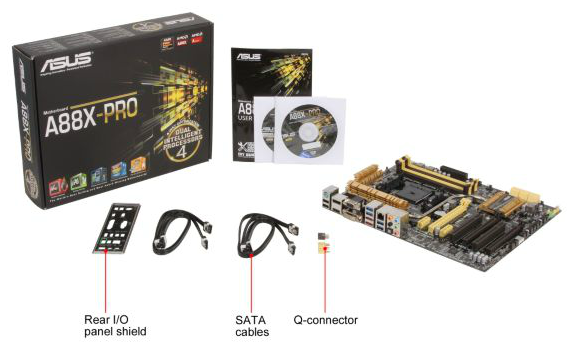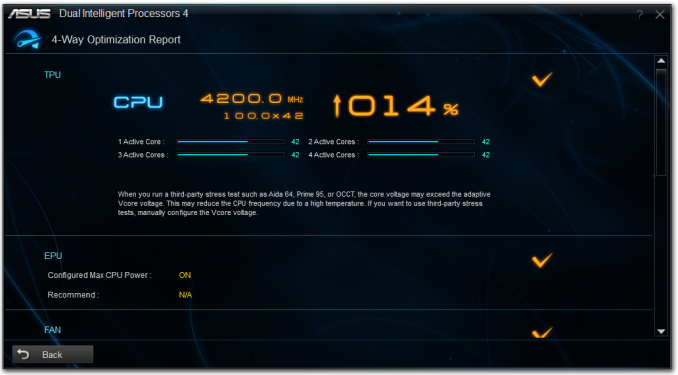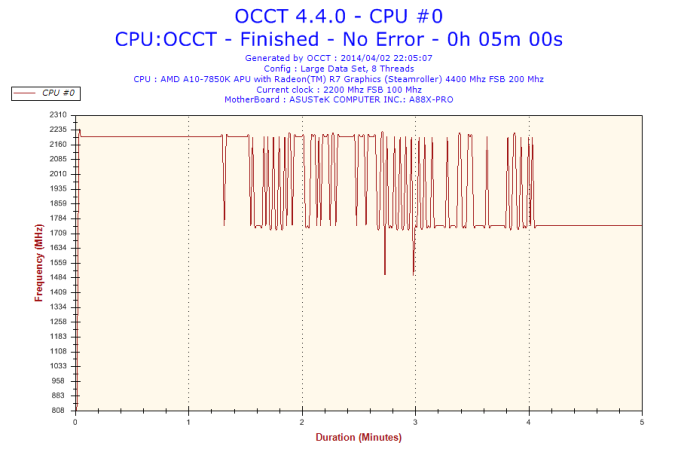ASUS A88X-Pro Review: Kaveri, Kaveri, Quite Contrary
by Ian Cutress on April 22, 2014 11:59 AM EST- Posted in
- Motherboards
- AMD
- Asus
- Kaveri
ASUS A88X-Pro In The Box
Being the top of the line ASUS A88X product, we should be expecting something more than the average in the box for the A88X-Pro. The downside to this is the price. Because the motherboard is $124, we have had other motherboards in this price range offer next to nothing apart from the basics. It all boils down to how aggressive the pricing of the motherboard is for this segment – in the box contents can add value but only when the margin is there or price is no object.
In the ASUS A88X-Pro we get the following:
Driver DVD
Manual
Rear IO Shield
Four SATA Cables
Q-Connectors
Admittedly this is two more SATA cables than the standard, however when a system offers 8 SATA 6 Gbps connectors it would seem rather tight to offer less than four. I was not expecting a USB 3.0 connector due to the lack of a second USB 3.0 header, but because the system has four USB 2.0 headers I could be forgiven in expecting some tool to take advantage of those, either via a front or rear panel.
ASUS A88X-Pro Overclocking
Experience with ASUS A88X-Pro
Overall our overclocking experience on A88X with our A10-7850K is a bit disappointing. Most motherboards we have tested up until this point find the limit of our CPU early on, and the resulting high temperatures cause the CPU to throttle. 4.2 GHz seems to be the main limit, but the A88X-Pro does at least stretch that a bit to 4.3 GHz in our testing. In fact 4.4 GHz seemed plausible, but the throttling was present during our OCCT test.
One point I would like to make to ASUS would be in automatic overclock options. I enjoy having access to a dynamic scaling utility such as the 4-Way Optimization tool, however by implementing a series of presets to choose from would be beneficial. Something to think about in the future I would imagine.
Methodology:
Our standard overclocking methodology is as follows. We select the automatic overclock options and test for stability with PovRay and OCCT to simulate high-end workloads. These stability tests aim to catch any immediate causes for memory or CPU errors.
For manual overclocks, based on the information gathered from previous testing, starts off at a nominal voltage and CPU multiplier, and the multiplier is increased until the stability tests are failed. The CPU voltage is increased gradually until the stability tests are passed, and the process repeated until the motherboard reduces the multiplier automatically (due to safety protocol) or the CPU temperature reaches a stupidly high level (100ºC+). Our test bed is not in a case, which should push overclocks higher with fresher (cooler) air.
Automatic Overclock:
Using the 4-Way Optimization tool in AI Suite, our system was overclocked to 4.2 GHz:
This gave a PovRay score of 933, compared to the stock score of 820.
Manual Overclock:
We started our manual overclocking in the BIOS, with the CPU set to 1.1 volts and 4.0 GHz. Given that the stock voltage reading was 1.288 volts, it was no surprise that it took 1.225 volts set in the BIOS to get 4.0 GHz stable. The system was consistently stable to 4.3 GHz, however 4.4 GHz was a step too far:
The 4.4 GHz setting was stable for at least a minute, however a sustained workload gave the following CPU frequency profile over five minutes:














34 Comments
View All Comments
mikato - Wednesday, April 23, 2014 - link
"ASUS has suggested that my review CPU from AMD is from an initial batch of A10-7850K which may have higher-than-retail leakage issues. We are currently investigating this further.""Signs may point towards early batch of Kaveri processors that draw higher current, or the silicon lottery."
Wow, does this mean you are going to rerun the power consumption numbers from the Kaveri review and give us new graphs? You really should.
"we take a series of 170 images in various sizes and formats and convert them all into 640x480 .gif files, maintaining the aspect ratio"
I'm just curious how that's possible? Do you use blank bars on the sides? Or do they all have the same length:width ratio to match 640x480 to begin with?
Hrel - Thursday, April 24, 2014 - link
"A side note: we are looking into the restarting flaw that seems to occur during our specialised benchmark under high CPU load. Signs may point towards early batch of Kaveri processors that draw higher current, or the silicon lottery. We need to get a newer one in to retest our Photoscan benchmark."The fact that you still recommended this motherboard, despite the above quote, makes this sites recommendations meaningless. You're AMD bias is only going to do harm, not good. Please stop yourselves from showing such obvious favoritism. AMD platforms are less stable than Intel, this is a long known fact.
silverblue - Sunday, April 27, 2014 - link
And this is the sort of FUD that AMD and its customers have to put up with.Haravikk - Sunday, April 27, 2014 - link
It's nice to see AMD still getting some good performance motherboards. This said, I have to say I really prefer the layout of the ASRock FM2A88-ITX+ motherboard, and wish more motherboards would do something similar. While it does get a little tight on the CPU cooler to have the memory angled "horizontally" towards the "top" of the motherboard, it just gives much better airflow and cooler RAM in general; I wish more manufacturers would do this, and just leave cooler manufacturers to adapt.